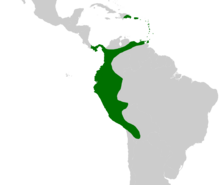Our website is made possible by displaying online advertisements to our visitors.
Please consider supporting us by disabling your ad blocker.
Aiphanes
| Aiphanes | |
|---|---|

| |
| Aiphanes horrida at Jena botanical garden | |
| Scientific classification | |
| Kingdom: | Plantae |
| Clade: | Tracheophytes |
| Clade: | Angiosperms |
| Clade: | Monocots |
| Clade: | Commelinids |
| Order: | Arecales |
| Family: | Arecaceae |
| Subfamily: | Arecoideae |
| Tribe: | Cocoseae |
| Genus: | Aiphanes Willd. |
| Type species | |
| Aiphanes horrida | |
| Diversity | |
| About 26 species | |

| |
| Native distribution of Aiphanes | |
| Synonyms[1] | |
|
Martinezia (sensu Kunth, not Ruiz y Pavón) | |
Aiphanes is a genus of spiny palms which is native to tropical regions of South and Central America and the Caribbean.[2] There are about 26 species in the genus (see below), ranging in size from understorey shrubs with subterranean stems to subcanopy trees as tall as 20 metres (66 ft). Most have pinnately compound leaves (leaves which are divided into leaflets arranged feather-like, in pairs along a central axis); one species has entire leaves. Stems, leaves and sometimes even the fruit are covered with spines. Plants flower repeatedly over the course of their lifespan and have separate male and female flowers, although these are borne together on the same inflorescence. Although records of pollinators are limited, most species appear to be pollinated by insects. The fruit are eaten by several birds and mammals, including at least two species of amazon parrots.
Carl Ludwig Willdenow coined the name Aiphanes in 1801. Before that, species belonging to the genus had been placed in Bactris or Caryota. The name Martinezia had also been applied to the genus, and between 1847 and 1932 it was generally used in place of Aiphanes. Max Burret resurrected the name Aiphanes in 1932 and laid the basis for the modern concept of the genus. Aiphanes is most closely related to several other genera of spiny palms—Acrocomia, Astrocaryum, Bactris and Desmoncus. Two species are widely planted as ornamentals and the fruit, seeds or palm heart of several species have been eaten by indigenous peoples of the Americas for millennia.
Previous Page Next Page


